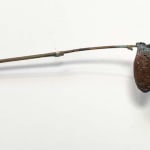



Giorgio Andreotta Calò
Further images
The Icarus (branch) series was born as a sculptural evolution of Icarus, a project developed by Giorgio Andreotta Calò starting in 2019 and originally constituted in the form of a medium-length film.
In December 2020, the artist intervened on the former butterfly pavilion of Emmen (Netherlands), abandoned for years and destined for demolition. Thanks to the collaboration on-site of two entomologists, the building was temporarily repopulated as a butterfly colony, in an ultimate symbolic act preceding its destruction. In the film, not as documentation of the performative act but as a transposition of the butterfly’s flight attempt, everything gradually converges in the manifestation of the myth of Daedalus and Icarus.
The project subsequently expanded into a much broader constellation of works, translations, and transpositions of the experience in Emmen into various forms and media. In Icarus (branch), the poetic matrix of the film is developed and reinterpreted autonomously within the specific grammar of sculptural language.
Technically, the work consists of a metal branch (bronze, silver, or brass) on which hangs a series of cocoons in silver, bronze, or raw silk. The branch, fixed to the wall by welded metal hooks of the same alloy, is made through direct casting from actual organic specimens collected by the artist.
The same goes for the cocoons, which are sometimes empty natural cocoons in raw silk.
The work can be activated cyclically by one or more natural cocoons containing within them a lepidopteran at the chrysalis stage. At an unpredictable moment, the pupa, transformed into a moth, emerges from the cocoon. The sculpture then becomes a revelation, for a contingent interval, of the lepidopteran’s flight attempt.
Over the course of the insect’s silent metamorphosis within the cocoon, the work charges itself with a latent biological dimension of life, reconfiguring its status from dead matter in nature to a living one. The unpredictable dimension of the event places the flight in a temporal and ethereal suspension.
The metal elements, created through direct micro-casting, make each work in the series a unique specimen. Unlike the lost-wax technique, capable of reproducing the original model in series, in Icarus (branch) the organic matrix is consumed in the metal casting process.
The branch and the cocoon, inserted directly into the casting cylinder, are incinerated by high temperatures, leaving in negative the space that will be occupied by molten metal. The organic element, as in an alchemical operation, is transmuted into its metallic counterpart.
Metamorphosis, the central component of the film, is reconfigured here in a continuous dialectic—between the wooden branch and its metallic copy, of which it is the formal memory; between the cocoons in metal and their complements in silk.
The same cocoon shell recalls the shape of a shell already explored by Calò in his series Pinna Nobilis.
The coexistence of different states of matter echoes the various phases of the lepidopteran’s biological metamorphosis—the manifestation of the passage from chrysalis to butterfly.
The boundaries between mineral, vegetal, and animal are confused and crystallize into the equilibrium of a single sculptural form. In Icarus (branch), from the neutral space of the wall, a metal branch organically emerges, extending seamlessly into silver and silk cocoons, into chrysalises and flying lepidopterans. In a single coherent sculptural movement, the work articulates and recomposes the various elements into a new atmosphere—biological and post-human.
Join our mailing list
* denotes required fields
We will process the personal data you have supplied in accordance with our privacy policy (available on request). You can unsubscribe or change your preferences at any time by clicking the link in our emails.



